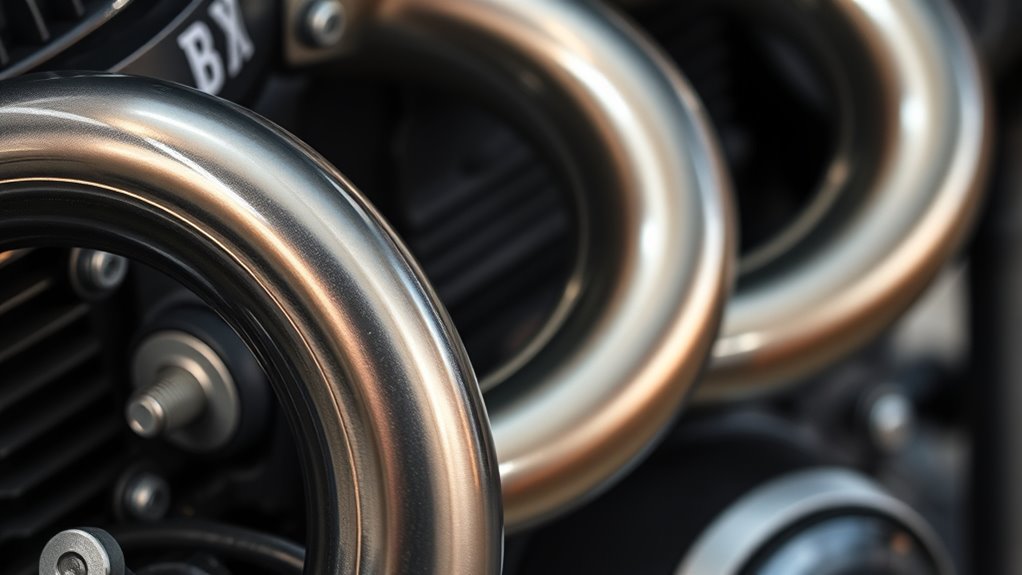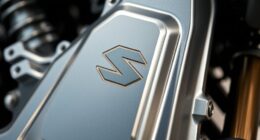Kawasaki intake resonance tuning involves adjusting your bike’s intake system to improve airflow and pressure wave behavior, boosting torque, horsepower, and throttle response. By changing intake runner length, adding Helmholtz chambers, or customizing the airbox, you can target specific RPM ranges for peak performance. Fine-tuning these elements helps your engine breathe better and run smoother. If you want to learn more about how to implement these modifications effectively, there’s plenty of useful info ahead.
Key Takeaways
- Adjust intake runner length and shape to optimize pressure wave timing for specific Kawasaki engine RPM ranges.
- Incorporate Helmholtz chambers to amplify pressure waves and improve airflow efficiency.
- Use tunable intake components to fine-tune resonance effects based on riding style and engine specs.
- Test and refine resonance chamber design through dynamometer or track testing for maximum performance gains.
- Proper resonance tuning enhances Kawasaki engine torque, horsepower, throttle response, and overall engine smoothness.

If you’re looking to improve your Kawasaki’s engine performance, tuning the intake resonance can make a significant difference. The way your engine breathes directly impacts power, throttle response, and efficiency. One effective method to optimize airflow is through air intake modifications, which involve adjusting or upgrading the intake system to better suit your riding style and engine specs. But beyond simple upgrades, resonance tuning techniques can fine-tune how the air moves through your engine at specific RPM ranges, maximizing performance gains.
Resonance tuning involves understanding how sound waves and pressure waves behave inside your intake tract. When the intake system is properly tuned, these waves amplify each other at certain engine speeds, boosting airflow into the cylinders. This can lead to noticeable increases in torque and horsepower without the need for extensive engine modifications. To achieve this, you’ll want to focus on lengthening or shortening intake runners, installing Helmholtz resonators, or adjusting the airbox design to manipulate the timing of these pressure waves. These modifications are subtle but, when done correctly, create a more efficient flow of air that matches your engine’s firing cycle.
Resonance tuning amplifies airflow by adjusting intake runner length and Helmholtz chambers for optimal engine performance.
Implementing air intake modifications with resonance tuning techniques requires some understanding of your Kawasaki’s specific engine characteristics. For example, longer intake runners tend to enhance low-end torque by delaying the arrival of pressure waves, while shorter runners favor high RPM power. By experimenting with different lengths and shapes, you can tailor the intake to your preferred riding conditions. Some riders opt for adjustable intake systems that allow quick changes, enabling them to switch between performance profiles depending on whether they’re cruising or racing.
Pay careful attention to the design and placement of resonance chambers or Helmholtz resonators, which can target particular RPM ranges. These chambers work by creating constructive interference at specific frequencies, effectively amplifying airflow at desired engine speeds. Proper resonance tuning can also smooth out power delivery, minimizing dips or flat spots that often occur with poorly tuned systems. When combined with strategic air intake modifications, resonance tuning techniques help optimize your Kawasaki’s engine breathing, leading to better throttle response, increased power, and improved fuel efficiency.
To get the most out of these adjustments, it’s essential to test and fine-tune your setup. Use a dynamometer or track testing to verify gains and make incremental changes. Remember, resonance tuning is both science and art—small adjustments can have significant effects. With patience and precision, you can transform your Kawasaki’s intake system into a finely tuned powerhouse, delivering smoother acceleration, more responsive throttle, and overall enhanced performance.
Frequently Asked Questions
Does Intake Resonance Tuning Improve Fuel Economy?
Yes, intake resonance tuning can improve your fuel efficiency and engine performance. By optimizing the air intake system, you help your engine breathe better, which can lead to more complete combustion and better power delivery. This means your motorcycle uses fuel more efficiently, saving you money and reducing emissions. You’ll notice smoother acceleration and potentially better mileage, making intake resonance tuning a valuable upgrade for both performance and economy.
Can Resonance Tuning Be Performed on All Kawasaki Models?
Not all Kawasaki models are compatible with intake resonance tuning, as model compatibility varies. You should check the specific tuning procedures for your motorcycle model, since some may require specialized parts or adjustments. To guarantee safe and effective tuning, consult your owner’s manual or a professional mechanic familiar with Kawasaki bikes. This way, you can enjoy the benefits of resonance tuning without risking damage or voiding warranties.
What Tools Are Needed for Resonance Tuning Adjustments?
You’ll need basic tuning tools like screwdrivers and wrenches to make resonance adjustments. To optimize intake pressure, consider using a vacuum gauge or pressure sensor for precise measurements. These tools help you fine-tune the intake resonance, improving performance. Make sure you have a clear understanding of your motorcycle’s intake system and follow safety procedures. With the right tools, you can effectively enhance your Kawasaki’s intake resonance.
How Often Should Resonance Tuning Be Checked or Maintained?
You should check and maintain resonance tuning every 3,000 to 5,000 miles or whenever you notice a change in engine performance. Regularly monitoring the resonance frequency helps guarantee ideal intake efficiency. Tuning intervals depend on riding conditions, modifications, and environmental factors. Keep an eye on engine response and sound, and adjust your resonance tuning accordingly to maintain peak performance and fuel efficiency.
Are There Any Risks Associated With Incorrect Resonance Tuning?
Missing proper resonance tuning can cause your engine to suffer serious damage or performance loss—like a silent assassin attacking your ride. Incorrect resonance tuning risks engine damage and efficiency issues, so it’s vital to get it right. If you ignore tuning or do it improperly, you could end up with increased wear, reduced power, and costly repairs. Always make certain your resonance tuning is precise to keep your engine healthy and performing at its best.
Conclusion
Think of your Kawasaki as a finely tuned instrument, where intake resonance is the secret melody. When you master this tuning, you’re not just enhancing performance—you’re opening the bike’s true spirit. Every note of airflow becomes a symbol of your connection to the machine, creating harmony between power and precision. Embrace this tuning as your key to riding with confidence and passion, transforming your ride into a symphony of mastery on every road.








